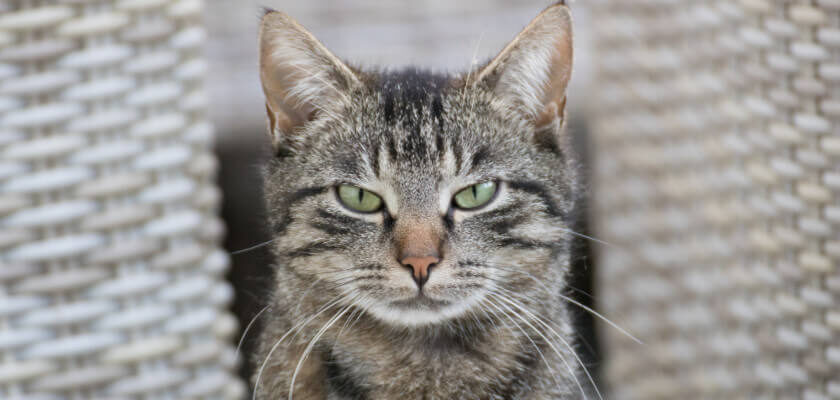Most cats, except for some very peculiar breeds such as sphynx or elf, are covered entirely with hair of different types. While most of it provides insulation and protection against the external environment, there is also a special type of cat hair: whiskers. These stiff hairs on your cat’s face and forelegs are truly amazing, and help cats assess the surrounding environment. Interestingly, they serve as touch sensors, as well as perform a communicative function, i.e., they can reveal your cat’s mood!
What are cat whiskers?
Whiskers, known also as vibrissae or tactile hairs, are a type of flexible and stiff hair in cats that foster navigation in challenging environments. Whiskers grow in various groups around your pet’s body: on either side of their mouth, above the eyes, as well as on their jaw, ears, and front legs. Unlike other kinds of hair, whiskers go deep into your cat’s skin and are connected to both the muscular and nervous systems. Their role is to send sensory messages to your furry friend’s brain. Therefore, cats use their whiskers to explore the world. When it comes to whiskers on their muzzle, there are always 24 of them. Each side has 12 whiskers, which are symmetrically distributed so that your cat can precisely measure the environment on both sides.
Why do felines use their whiskers?
Whiskers are a multi-functional sensory tool that guides your cat through daily activities. They are mostly used for navigation, measuring, and mood communication.
Whiskers are so sensitive because the follicles they grow from are surrounded by nervous cells, which transmit tactile information to your cat’s brain. The cells are stimulated once your cat’s whiskers are exposed to vibrations. Even the smallest movement, e.g., caused by an air current, is registered by the cells and communicated to your cat’s brain. Therefore, they help the cat navigate in almost all conditions. The primary role of face whiskers is to allow your cat to better evaluate the environment, estimate distances, and avoid threats to their eyes. Moreover, thanks to them, they can safely move around at night.
Measurements
Whiskers help your cat measure objects and openings. They are roughly as wide as your cat’s body and act as a sort of ruler that tells your cat if they can fit into the opening. Have you ever seen a cat who sticks their head into a container? This is probably because they are determining whether they can fit into it or not.
Mood communication
Apart from being highly sensitive, whiskers can also facilitate communication between you and your cat, as their additional role is to indicate their mood. When your cat is angry, irritated, or gets ready to attack, their facial whiskers pull back. In turn, when your friend is happy and curious, their whiskers are more relaxed and pushed forward.
Can I trim my cat’s whiskers?
All kinds of cat’s whiskers, including facial and carpal whiskers, have no nerves, so it is not painful if your cat loses them. If you see that your small friend lacks one or two of them, don’t be alarmed. This is natural. When cats get old, their whiskers can shed. Fortunately, they usually grow back in a few months. If your cat is missing a few whiskers, this doesn’t usually affect their ability to navigate. The situation is much worse if a cat loses all of them. This is why you should never intentionally cut them. A cat without whiskers is not able to properly move around and therefore can experience fear or disorientation.
There are several diseases that can affect your cat’s hair coat such as infections or vasculitis. These can also attack whiskers. As a result, the hairs can fall out or grow slowly. If you notice that your cat’s whiskers are weak, better ask the veterinarian for help. Some medications such as chemotherapy may also affect the condition of your cat’s whiskers.
How long does it take for whiskers to grow back?
Has your cat accidentally broken their whiskers? Or perhaps they lost them due to sickness? Your cat needs some time for them to grow back. It usually takes from 6 weeks up to 3 months for a cat’s whisker to grow to the appropriate length. Once they grow, you may see that they sometimes change colors. It should not be surprising that a whisker that was once white grows back as black.
Whiskers fatigue – how to help your cat
Some cats may also experience a condition called whiskers fatigue, which is usually caused by chronic pressure put on their whiskers. If you see that your cat no longer wants to eat or drink from a bowl, or tries to scoop food out on the floor, consider getting them a wider bowl and bring them to the vet, as they may be suffering from sensitive whiskers.
Similar Posts:
- Do Dogs Have Whiskers Like Cats? All about Whiskers and Their Purpose in Dogs
- Do Cats Have 9 Lives? What Is The Story Behind The Myth?
- Do Cats Have Night Vision And See In The Dark? Cats See The World Differently
- Why Does My Cat Reach His Paw Out to Me? Answers for Curious Cat Parents
- Can Cats Eat Yogurt? Is Dairy Safe for Cats?
- “Why Does My Cat Lick My Hair” and Other Cat Eccentricities
- Do Cats Know Their Names? Let’s See What Science Says About That
- Can Cats Eat Garlic? What Is Garlic Poisoning and How to Prevent It?

